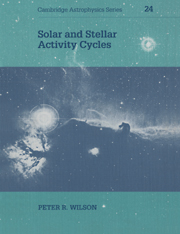Book contents
- Frontmatter
- Contents
- Preface
- Acknowledgments
- 1 Introduction
- 2 Historical survey
- 3 The structure of the Sun and the phenomena of activity
- 4 The equations of magnetohydrodynamics and magnetohydrostatics
- 5 The one-dimensional configuration of the cycle
- 6 Heuristic models of the solar activity cycle
- 7 Stellar activity and activity cycles
- 8 The two-dimensional representation of the extended activity cycle
- 9 The origin of the large-scale fields
- 10 The reversal of the polar magnetic fields
- 11 The role of dynamo theory in cyclic activity
- 12 Helioseismology and the solar cycle
- 13 Cyclic activity and chaos
- 14 Forecasting the solar cycle
- 15 Summary and conclusions
- Author index
- Subject index
9 - The origin of the large-scale fields
Published online by Cambridge University Press: 27 October 2009
- Frontmatter
- Contents
- Preface
- Acknowledgments
- 1 Introduction
- 2 Historical survey
- 3 The structure of the Sun and the phenomena of activity
- 4 The equations of magnetohydrodynamics and magnetohydrostatics
- 5 The one-dimensional configuration of the cycle
- 6 Heuristic models of the solar activity cycle
- 7 Stellar activity and activity cycles
- 8 The two-dimensional representation of the extended activity cycle
- 9 The origin of the large-scale fields
- 10 The reversal of the polar magnetic fields
- 11 The role of dynamo theory in cyclic activity
- 12 Helioseismology and the solar cycle
- 13 Cyclic activity and chaos
- 14 Forecasting the solar cycle
- 15 Summary and conclusions
- Author index
- Subject index
Summary
There's some who'll say that what I've said is wrong,
while others claim they've known it all along.
T. Simon, introducing the 7th Cool Stars WorkshopIntroduction
Although not the most spectacular phenomenon of the solar cycle and undetectable in stellar cycles, the large-scale magnetic field patterns on the Sun play an important role in solar cyclic activity and in the attempts to understand the solar cycle discussed in Chapter 6. In relaxation models such as the Babcock model (see§ 6.2), the reversal of the polar fields by the poleward drift of large-scale fields is crucial, and in the Leighton-Sheeley flux-transport model the large-scale fields arise solely from the decay of active-region fields.
However, magnetic flux emerges at the surface of the Sun in the form of magnetic bipoles whose dimensions range across a wide spectrum, from the largest active regions with dimensions up to 100 000 km, down to the small intra-network elements of order 500 km. Stenflo (1992) has noted that the total flux emerging in the smaller elements exceeds that emerging as large active regions by several orders of magnitude, and there is no a priori reason why regions from the large-scale end of this spectrum should be the only\ contributors to the large-scale field patterns and thus to the reversal of the polar fields.
In this chapter we describe recent studies of the evolution of the large-scale field patterns at the beginnings of Cycles 20, 21, and 22. In Chapter 10 we look at the polar fields near the maximum of Cycle 22.
- Type
- Chapter
- Information
- Solar and Stellar Activity Cycles , pp. 142 - 172Publisher: Cambridge University PressPrint publication year: 1994



